Selected works

- Moor Place, Hertfordshire (1775) [2]
- Preston Hall, Midlothian (1791) [1]
- Rotunda, Leicester Square, London (1793) [3] [4]
- Old Parish Church, Peterhead (1804) [5]
- Nelson's Column, Montreal (1809) [6]
- Crimond Church (1812) [7]
Robert Mitchell | |
|---|---|
| Born | Scotland |
Robert Mitchell was a Scottish architect, prominent in the late 18th century and early 19th century. [1] He worked for a period with his brother and fellow architect John Mitchell. [1]

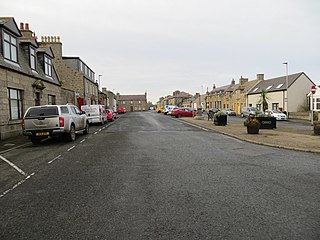
Rosehearty is a settlement on the Moray Firth coast, four miles west of the town Fraserburgh, in the historical county of Aberdeenshire in Scotland. The burgh has a population of approximately 1,300 with about 25 per cent of pensionable age.
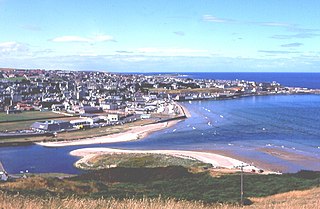
Banff is a town in the Banff and Buchan area of Aberdeenshire, Scotland. It is situated on Banff Bay and faces the town of Macduff across the estuary of the River Deveron. It is a former royal burgh, and is the county town of the historic county of Banffshire.

Buchanhaven is a village in Aberdeenshire, Scotland, dating to around 1739. It is one mile north of Peterhead town centre, and near to the mouth of the River Ugie. It has its own school, Buchanhaven Primary School, which caters for children in Buchanhaven and the nearby Waterside estate. It is also the home of Buchanhaven Hearts F.C.

Deer Abbey was a Cistercian monastery in Buchan, Scotland. It was founded by 1219 under the patronage William Comyn, jure uxoris Earl of Buchan, who is also buried there.
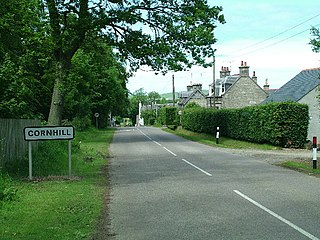
Cornhill is a small village close to Banff, Aberdeenshire, Scotland. It lies 5 miles (8.0 km) to the south of Portsoy. The village was originally a burgh of a feudal barony and is now a farming community.

Sandend is a small fishing village near Banff and Portsoy, Scotland, typical of the area. It was "a considerable seatown as early as 1624".

Fordyce is a village in Aberdeenshire, Scotland that is slightly inland from the point where the Burn of Fordyce meets the sea between Cullen and Portsoy. It has existed since at least the 13th century. In 1990, Charles McKean wrote that Fordyce was "a sheer delight to discover, concealed as it is from the passing eye by hills and rolling countryside".

Cairnbulg Castle is a z-plan castle situated in Cairnbulg, Aberdeenshire, Scotland. It was described by W. Douglas Simpson as one of the nine castles of the Knuckle, referring to the rocky headland of north-east Aberdeenshire. It stands by the River Philorth and was originally known as Philorth Castle. The 17th-century Philorth Castle, an L-plan house consisting of a sizeable crow-stepped block, was demolished after a fire in 1915.
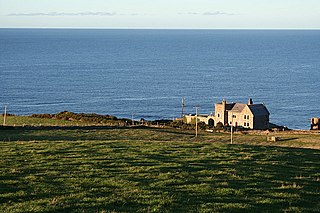
Dundarg Castle is a ruined castle about 2 kilometres (1.2 mi) north-northeast of New Aberdour, Aberdeenshire, Scotland, built within the ramparts of an earlier Iron Age promontory fort. It was described by W. Douglas Simpson as one of the nine castles of the Knuckle, referring to the rocky headland of North-East Aberdeenshire, and by Charles McKean as "Scotland's answer to Tintagel". It became a small Celtic monastery for a period.

Pitsligo Castle is a ruined castle half a mile east of Rosehearty, Aberdeenshire, Scotland. Modified in the 1570s by the Forbes of Druminnor, it was described by W. Douglas Simpson as one of the nine castles of the Knuckle, referring to the rocky headland of North-East Aberdeenshire. It is listed by Historic Environment Scotland as a scheduled monument.

Brethren Meeting House is a Category C listed building at 26 Gordon Street in Boddam, Aberdeenshire, Scotland. It was formerly a late-Victorian-era Wesleyan church. A bellcote is on the gable, without a bell but with a "spiky" finial in place.

The Reform Monument is a Category B listed monument on Broad Street, at its junction with Longate, in Peterhead, Scotland, built in 1833. A Roman doric column, it is surmounted by arms of Earl Marischal, inspired by the gateway of Inverugie Castle.

Old Parish Church is a Category A listed building located on Maiden Street in Peterhead, Aberdeenshire, Scotland. Local brothers Robert and John Mitchell built the church between 1804 and 1806, to a design by Alexander Laing, of Edinburgh. Its Burgerhuys bell dates to 1647.

Sandford Lodge is a Category B listed building in Peterhead, Aberdeenshire, Scotland. A former farmhouse, described by Charles McKean as a "miniature mansion house", it was built around 1800; today, only the shell of the building remains, after a fire in the early hours of 8 August 2015.

Dalyrmple Hall is a building in Fraserburgh, Scotland, standing on Dalyrmple Street at its junction with Station Brae. Category C listed, in the Scottish baronial style, it dates to 1881. Its architects were Aberdeen-based Jenkins & Marr.
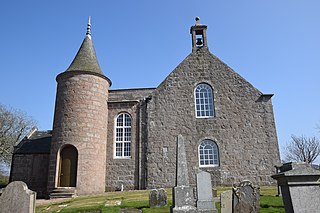
St Olaf's Church is a Category B listed building in Cruden, Aberdeenshire, Scotland, dating to 1776. It is of Church of Scotland denomination.

Cruden Bay Hotel was a hotel in Cruden Bay, Aberdeenshire, Scotland. Following the success of the Palace Hotel in Aberdeen, it was built between 1897 and 1899 by the same owners. It closed in 1932 and was demolished between 1947 and 1952.
Longate is a street in Peterhead, Scotland. It runs for about 0.18 miles (0.29 km), from North Street in the north to Broad Street in the south.

Broad Street is a street in Peterhead, Scotland. It runs for about 640 feet (200 m), from Seagate in the east to Marischal Street and Tolbooth Wynd in the west.

Peterhead Harbour is a harbour in Peterhead, Aberdeenshire, Scotland. Situated immediately northeast of Peterhead Bay, it is composed of three harbours: Port Henry, North Harbour and South Harbour. The harbour is a Category B listed structure.
![]() This article incorporates text from a publication now in the public domain : "Mitchell, Robert". Dictionary of National Biography . London: Smith, Elder & Co. 1885–1900.
This article incorporates text from a publication now in the public domain : "Mitchell, Robert". Dictionary of National Biography . London: Smith, Elder & Co. 1885–1900.